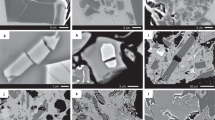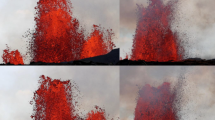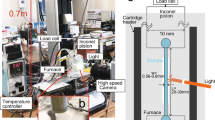Abstract
Magma fragmentation—the process by which relatively slow-moving magma transforms into a violent gas flow carrying fragments of magma—is the defining feature of explosive volcanism. Yet of all the processes involved in explosively erupting systems, fragmentation is possibly the least understood1,2. Several theoretical and laboratory studies on magma degassing3,4,5,6,7 and fragmentation8,9,10,11 have produced a general picture of the sequence of events leading to the fragmentation of silicic magma12,13,14. But there remains a debate2 over whether magma fragmentation is a consequence of the textural evolution of magma to a foamed state where disintegration of walls separating bubbles becomes inevitable due to a foam-collapse criterion, or whether magma is fragmented purely by stresses that exceed its tensile strength. Here we show that tube pumice—where extreme bubble elongation is observed—is a well-preserved magmatic ‘strain marker’ of the stress state immediately before and during fragmentation. Structural elements in the pumice record the evolution of the magma's mechanical response from viscous behaviour (foaming and foam elongation) through the plastic or viscoelastic stage, and finally to brittle behaviour. These observations directly support the hypothesis that fragmentation occurs when magma undergoes a ductile–brittle transition and stresses exceed the magma's tensile strength.
This is a preview of subscription content, access via your institution
Access options
Subscribe to this journal
Receive 51 print issues and online access
$199.00 per year
only $3.90 per issue
Buy this article
- Purchase on Springer Link
- Instant access to full article PDF
Prices may be subject to local taxes which are calculated during checkout


Similar content being viewed by others
References
Cashman,K. V. & Mangan,M. T. in Volatiles in Magmas (eds Carroll, M. R. & Holloway, J. R.) 449–478 (Mineral. Soc. Am. Rev. Mineral. 30, 1994).
Dingwell,D. B. Volcanic dilemma: flow or blow? Science 273, 1054–1055 (1996).
Toramaru,A. Numerical study of nucleation and growth of bubbles in viscous magmas. J. Geophys. Res. 100, 1913–1931 (1995).
Proussevitch,A. A. & Sahagian,D. L. Dynamics and energetics of bubble growth in magmas: analytical formulation and numerical modelling. J. Geophys. Res. 103, 18223–18251 (1998).
Barclay,J., Riley,D. & Sparks,R. S. J. Analytical models for bubble growth during decompression of high viscosity magmas. Bull. Volcanol. 57, 422–431 (1995).
Bagdassarov,N., Dingwell,D. B. & Wilding,M. Rhyolite magma degassing: an experimental study of melt vesiculation. Bull. Volcanol. 57, 587–601 (1996).
Lyakhovsky,V., Hurwitz,S. & Navon,O. Bubble growth in rhyolitic melts: experimental and numerical investigation. Bull. Volcanol. 58, 19–32 (1996).
Papale,P. Strain-induced magma fragmentation in explosive eruptions. Nature 397, 425–428 (1998).
Mader,H. M., Phillips,J. C., Sparks,R. S. J. & Sturtevant,B. Dynamics of explosive degassing of magma: observations of fragmenting two-phase flows. J. Geophys. Res. 101, 5547–5560 (1996).
Alidibirov,M. & Dingwell,D. B. Magma fragmentation by rapid decompression. Nature 380, 146–148 (1996).
Klug,C. & Cashman,K. V. Permeability development in vesiculating magmas: implications for vesiculation, foam formation and fragmentation in lava fountains. Bull. Volcanol. 58, 87–100 (1996).
Dingwell,D. B. in From Magma to Tephra: Modelling Physical Processes of Explosive Volcanic Eruptions (eds Freundt, A. & Rosi, M.) 1–23 (Springer, Berlin, 1998).
Dingwell,D. B. in The Physics of Explosive Volcanic Eruptions (eds Gilbert, J. & Sparks, R. S. J.) 1–26 (The Geological Society of London, Special Publication 145, 1998).
Mader,H. M. in The Physics of Explosive Volcanic Eruptions (eds Gilbert, J. & Sparks, R. S. J.) 51–71 (The Geological Society of London, Special Publication 145, 1998).
Dingwell,D. B. & Webb,S. L. Structural relaxation in silicate melts and non-Newtonian melt rheology in igneous processes. Phys. Chem. Mineral. 16, 508–516 (1989).
Heiken,G. & Wohletz,K. Volcanic Ash 246 (University of California Press, Berkeley, 1984).
Houghton,B. F. & Wilson,C. J. N. A vesicularity index for pyroclastic deposits. Bull. Volcanol. 51, 451–462 (1989).
Dellino,P. & La Volpe,L. Fragmentation versus transportation mechanisms in the pyroclastic sequence of Monte Pilato-Rocche Rosse (Lipari, Italy) J. Volcanol. Geotherm. Res. 64, 211–231 (1995).
Thomas,N., Jaupart,C. & Vergniolle,S. On the vesicularity of pumice. J. Geophys. Res. 99, 15633–15644 (1994).
Viramonte,J. G. et al. Edad, genesis y mecanismos de erupción de las riolitas granatíferas de San Antionio de los Cobres, Privincia de Salta (Argentina) Actas IX Congreso Geológico Argentino, Bariloche, Argentina 3, 216–233 (1984).
Viramonte,J. G., Reynolds,J. H., Del Papa,C. & Disalvo,A. The Corte Blanco garnetiferous tuff: Adistinctive late Miocene marker bed in northern Argentina applied to magnetic polarity stratigraph in the Rio Yacones, Salta province. Earth Planet. Sci. Lett. 121, 519–531 (1994).
Heiken,G. Plinian eruptions in the Medicine Lake Highland, California, and the nature of underlying magma. J. Volcanol. Geotherm. Res. 4, 375–402 (1978).
Heiken,G. & Eichelberger,J. Eruptions at Chaos Crags, Lassen Volcanic National Park, California J. Volcanol. Geotherm. Res. 7, 443–481 (1980).
Gauthier,P. J., Déruelle,B., Viramonte,J. G. & Aparicio,A. Grenats des rhyolites de la caldéra de La Pava-Ramada (NW Argentine) et leurs xénolites granitíques. C. R. Acad. Sci. 318, 1629–1635 (1994).
Hess,K.-U. & Dingwell,D. B. Viscosities of hydrous leucogranitic melts: a non-Arrhenian model. Am. Mineral. 81, 1297–1300 (1996).
Dingwell,D. B., Bagdassarov,N. S., Bussod,G. Y. & Webb,S. in Experiments at High Pressure and Applications to the Earth's Mantle (ed. Luth, R. W.) 131–196 (Mineral. Assoc. Can. Short Course Handbook 21, 1993).
Chouet,B. A. Monitoring and Mitigation of Volcano Hazards (eds Scarpa, R. & Tilling, R.) (Springer, Berlin, 1996).
Stein,D. J. & Spera,F. J. Rheology and microstructure of magnetic emulsions: theory and experiments. J. Volcanol. Geotherm. Res. 49, 157–174 (1992).
Dingwell,D. B. in Structure and Dynamics of Silicate Melts (eds Stebbins, J. F., McMillan, P. W. & Dingwell, D. B.) 21–66 (Mineral. Soc. Am. Rev. Mineral. 32, (1995).
Martel,C., Dingwell,D. B., Spieler,O., Pichavant,M. & Holtz,F. Systematic foaming and fragmentation in synthetic melts. Eos 79, F981 (1998).
Acknowledgements
We thank J. G. Viramonte for discussions on the Ramadas eruption and field assistance. This work was supported by European Union, DAAD, DFG (Di 431) and MEC grants.
Author information
Authors and Affiliations
Rights and permissions
About this article
Cite this article
Martí, J., Soriano, C. & Dingwell, D. Tube pumices as strain markers of the ductile–brittle transition during magma fragmentation. Nature 402, 650–653 (1999). https://doi.org/10.1038/45219
Received:
Accepted:
Issue Date:
DOI: https://doi.org/10.1038/45219
This article is cited by
-
Crystal plasticity as an indicator of the viscous-brittle transition in magmas
Nature Communications (2017)
-
MeMoVolc consensual document: a review of cross-disciplinary approaches to characterizing small explosive magmatic eruptions
Bulletin of Volcanology (2015)
-
Transitions between fall phases and pyroclastic density currents during the AD 79 eruption at Vesuvius: building a transient conduit model from the textural and volatile record
Bulletin of Volcanology (2012)
-
Controls on magma permeability in the volcanic conduit during the climactic phase of the Kos Plateau Tuff eruption (Aegean Arc)
Bulletin of Volcanology (2010)
-
Characterization of juvenile pyroclasts from the Kos Plateau Tuff (Aegean Arc): insights into the eruptive dynamics of a large rhyolitic eruption
Bulletin of Volcanology (2009)
Comments
By submitting a comment you agree to abide by our Terms and Community Guidelines. If you find something abusive or that does not comply with our terms or guidelines please flag it as inappropriate.



